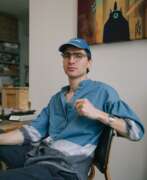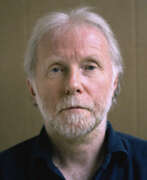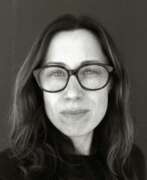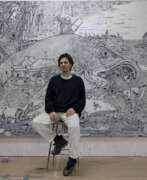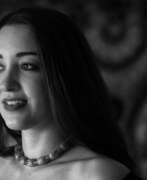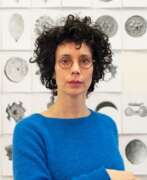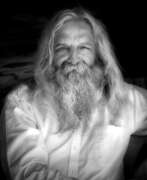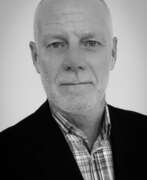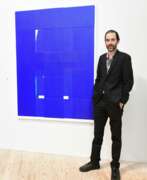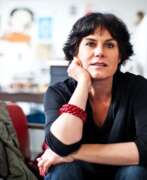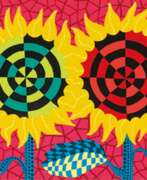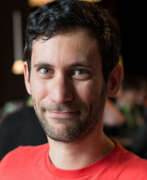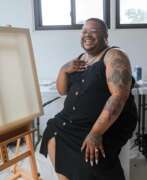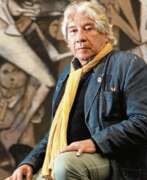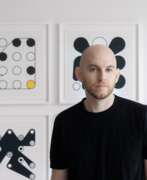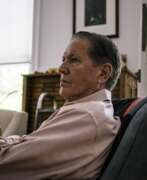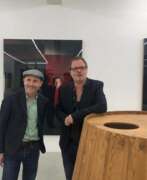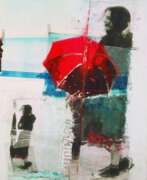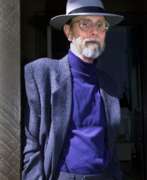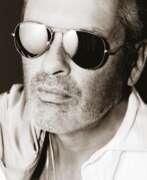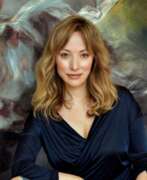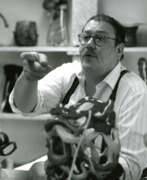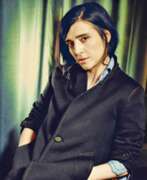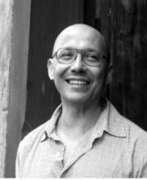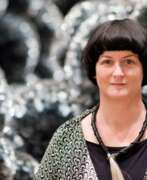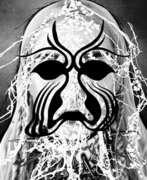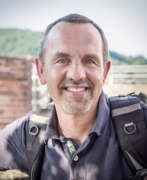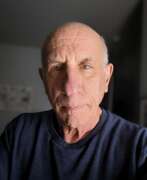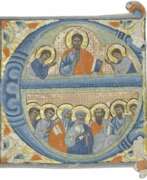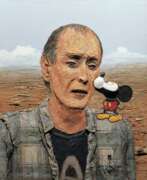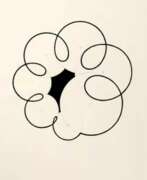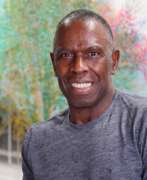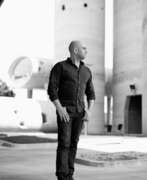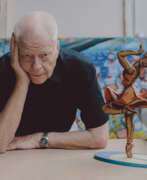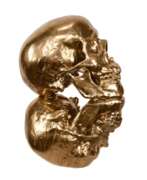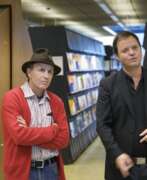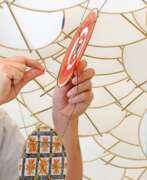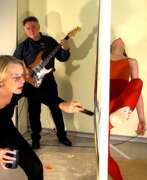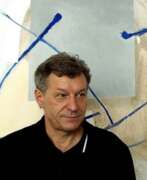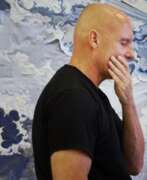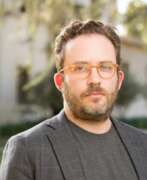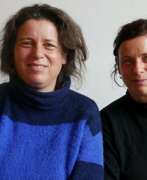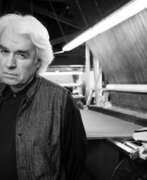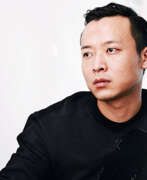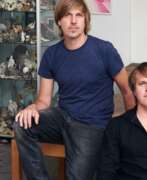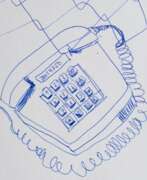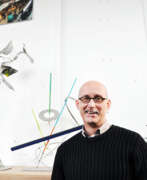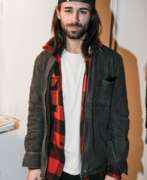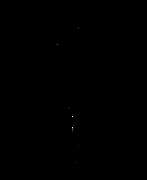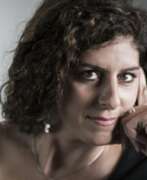Media artists
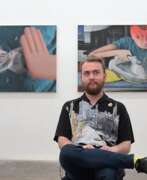

Trey Abdella is an American artist who lives and works in New York. The challenges of living in a complex cosmopolitan city has served as the inspiration for his artworks, although the paintings themselves are not specifically about New York.
Trey Abdella’s art strives to resonate with human experiences and feelings. Abdella utilises simple universal iconography referenced from internet memes, movies and cartoons found in contemporary culture. He blends these icons with various aspects of anxiety he or his friends experienced from different scenarios encountered in daily life, portraying the underbelly of society. Abdella’s paintings express insecurity, embarrassment, fear, terror, disgust, unspeakable desires and emotions that we must conceal everyday in order to abide with social conventions and expectations.
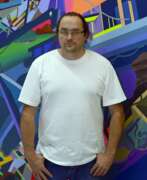

Franz Ackermann is a German media artist.
He studied at the Academy of Fine Arts in Munich and at the University of Fine Arts in Hamburg, lives and works in Berlin and Karlsruhe.
Franz Ackermann's work includes drawings, watercolors, murals, paintings and installations, which he complements with photographic works, projections and architectural models. His works deal with the themes of tourism, globalization and urbanism and reflect the social changes and political problems caused by increasing globalization.
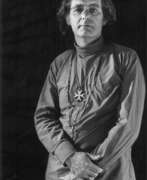

Marc Adrian is an Austrian conceptual artist and filmmaker.
Adrian studied sculpture at the Vienna Academy of Fine Arts, from 1953 he became interested in cinema, kinetics, rhythmic interference, problems of optical structures, etc. Adrian is considered one of the pioneers of film-oriented media art. He specialized in kinetic objects, anti-cinema and computer art.
Marc Adrian has taught at various universities in Europe and lectured to American students.
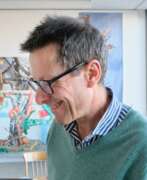

Urs Aeschbach is a Swiss media artist working in various techniques. Nature is always a pictorial theme in Urs Aeschbach's paintings. Her main characters are mushrooms, woody plants, animals, jellyfish, as well as dogs and horses. The artist's paintings are inspired by photographs and illustrations. In addition to paintings, Eschbach creates art and construction projects, video works, as well as constructions and installations.
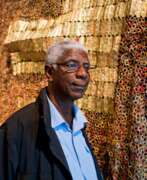

El Anatsui, a Ghanaian sculptor born on February 4, 1944, has carved a niche for himself with his iconic bottle-top installations. His artistry bridges his Ghanaian roots and his career in Nigeria, drawing international acclaim for its innovative use of everyday materials. Anatsui's large-scale metal tapestries, meticulously assembled from discarded bottle caps and copper wire, reflect a lifetime of exploring local materials and craftsmanship.
A citizen of the Ewe Nation, El Anatsui's lineage is entwined with art; he is the son of a master weaver of Kente cloth. This heritage shines through in his work, as does his formal art training from Kwame Nkrumah University of Science and Technology in Kumasi, Ghana. Anatsui's sculptures are not just art pieces but narratives woven from wood, metal, and clay, each piece shimmering with a story.
Anatsui's installations are a testament to his transformative vision, repurposing simple materials into mutable sculptures that resonate with a global audience. His works, often featured in prestigious museums and galleries, are more than sculptures; they are dialogues in sustainability and culture, inviting viewers to unravel the layers of meaning within.
For collectors, auctioneers, and art connoisseurs, El Anatsui's works are a blend of history, innovation, and artistry, making them significant additions to any collection. To stay updated on the latest from El Anatsui and his mesmerizing creations, sign up for our newsletter.
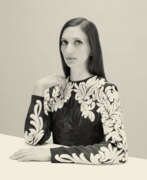

Tauba Auerbach is a visual artist working in many disciplines including painting, artists' books, sculpture and weaving. They live and work in New York.
A life-long student of math and physics, Auerbach's work contends with structure and connectivity on the microscopic to the universal scale.
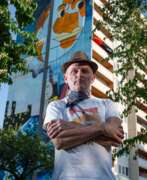

Jim Avignon, born Christian Reisz, is a German contemporary artist known for his bold, colourful and pop-inspired works. He has adopted a pseudonym to separate his creative persona from his everyday life.
Jim Avignon's art often incorporates elements of street art, graffiti and cartoon aesthetics. He is known for his playful and satirical approach to exploring themes such as consumerism, popular culture and the art world itself. His work is characterised by bright colours, simplistic forms and a distinctive graphic style that is both accessible and visually affecting.
In addition to his studio practice, Avignon is active in the art and music scenes, collaborating with musicians, DJs and performers. He has been associated with the Lowbrow art movement and has exhibited his work internationally, gaining recognition for his distinctive style and energetic artistic presence.
His ability to bridge the gap between visual art and popular culture has made him a prominent figure in contemporary art.
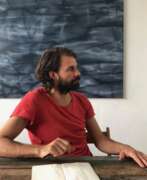

Janis Avotins is a Latvian artist, born in Riga in 1981. He was educated at the Latvian Academy of Art and the Royal College of Art in London. Avotins works in various media, including painting, drawing and sculpture, and his work is characterised by an experimental approach to form and technique. He has been recognised for his exhibitions in international galleries including Serpentin Galleries in London and the Venice Biennale.
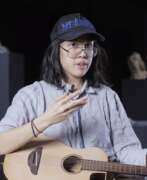

Trisha Baga is an American artist working in various media, including video installations, sculpture, painting and audio installations. She is known for her experiments with technology and often uses voice and body in her work.
Her work is often interactive and a combination of different elements such as projections, sounds, objects and movement. She is also known for her use of private elements such as mobile phones to create unique and personal works of art.
Trisha Baga draws on the heritage of sculpture, painting, music, photography and literature in her practice. Among the subjects and themes she explores are contemporary events, the worship of heroes and celebrities, and collective history. Baga's installations often include film, consisting of montages and collages of found footage and photographs, stacked in such a way that some images obscure others; the films are projected directly onto the wall, over personal items and rubbish from her studio so that they cast shadows on the projection.
Her work has been exhibited in many museums and galleries around the world, including the Museum of Modern Art in Los Angeles, the Museum of Modern Art in New York and the Venice Biennale.
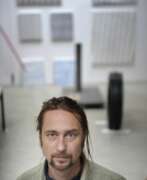

Thomas Baumann is an Austrian artist and filmmaker living and working in Vienna.
Baumann studied at the Academy of Fine Arts in Vienna, but is engaged in a wide range of creative endeavors. He mixes categories of art and challenges values and forms. Through his electronic sculptures, machine paintings, films and installations that give visitors their own freedom of action, Baumann searches for structural connections between material and mental spaces.
For example, one of his spatial sculptures with a pre-programmed score: silver foil moves in a certain rhythm, it straightens, contracts or expands. The sculpture is constantly changing its form - it destroys the shape it has just taken to create a new one. Baumann also constructs artworks from floor ropes, swings, doors, organ pipes and other objects. Many of his works contain acoustic elements. Since 1990, Bauman has also made films and videos.
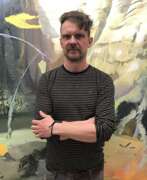

Tilo Baumgärtel is a German artist who lives and works in Leipzig.
His paintings go back to the works of social realism and large-format propaganda posters. The artist works with a variety of mediums and techniques. In addition to painting, he also uses lithography, drawings on paper, and video. Pictorial space and the creation of sometimes surrealistic landscapes is one of his central themes.
Tilo Baumgärtel also collaborates with theaters, developing sets and videos on scenography.
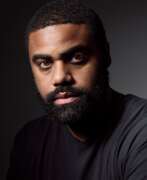

Kevin Beasley is an American artist working in sculpture, performance art, and sound installation. He lives and works in New York City. Beasley was included in the Whitney Museum of American Art's Biennial in 2014 and MoMA PS's Greater New York exhibition in 2015.
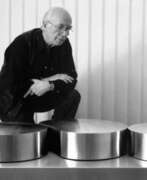

Friedrich Becker was a German artist, jeweler, and inventor of kinetic jewelry.
Friedrich Becker is one of the most influential jewelers of the second half of the twentieth century. He became known primarily for his avant-garde projects of kinetic jewelry and large kinetic objects.
Becker was interested in kinetics, the interaction of force and motion already during his apprenticeship years. He first trained as a mechanical engineer, then joined the aviation department. Only after World War II did he "make the reckless decision to become a jeweler." After training as a jeweler, he studied at the Werkkunstschule and then founded his own workshop in Düsseldorf, becoming a professor at the Düsseldorf University of Applied Sciences.
Becker experimented and supplemented various jewelry pieces with interchangeable stones and eventually developed kinetic jewelry. He was not only the inventor of kinetic jewelry, but also revolutionized the jewelry market with the introduction of stainless steel and synthetic gemstones. Each kinetic piece by Friedrich Becker is a perfect symbiosis of form, color and material.
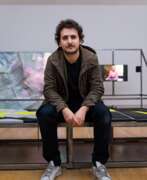

Neïl Beloufa is a French-Algerian artist born in 1985 in Algeria and raised in France. He currently lives and works in Paris. Beloufa's work covers a wide range of media, including sculpture, video and installations, and often deals with topics related to social and political issues.
Belufa's installations often use a combination of found objects, industrial materials and digital technologies such as screens and projectors. He often creates an immersive environment that encourages the viewer to physically and emotionally interact with the work.
One of Belufa's most famous works is Colonies, an installation that was exhibited at the Hammer Museum in Los Angeles in 2017. The installation was a series of interconnected rooms filled with sculptures, videos and soundscapes that explored themes related to colonisation and global power structures. Belufa's work has been exhibited internationally, including at the Palais de Tokyo in Paris, the New Museum in New York and the 2015 Venice Biennale. He has received numerous awards and prizes, including the Audi Talent Award in 2011 and the Marcel Duchamp Prize in 2015.
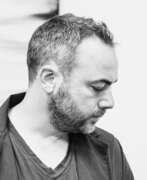

Walead Beshty is an American conceptual artist, photographer, sculptor and writer who lives and works in Los Angeles.
Born in London, Great Britain, he studied at Bard College and received a Master of Fine Arts degree from Yale University in 2002, and holds academic positions at universities across the United States.
Beschty is best known for his work in photography, but his creative interest spans a wide range, including sculpture, painting, installation and video. For example, in one of his popular works, the artist mails a series of glass windows of various sizes in cardboard boxes, and then displays the cracked and broken windows, damaged in transit, over the boxes in which they were packed.
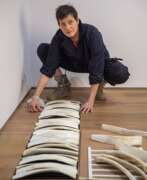

Alexandra Bircken is a German artist, designer and installer who graduated from the Central Saint Martin's College of Art and Design.
The main theme in Alexandra Birkcen's work is the shell. She explores and combines a variety of materials - wool, concrete, wood, bone, everyday objects and clothing, and creates sculptural objects from them. The artist also uses objects that she encounters in everyday life: cars, motorcycles, surgical shirts, rocking horses, skis. However, she strips them of their familiar contexts and surprises us with unusual combinations.
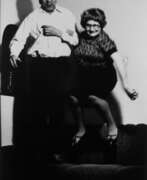

Bernhard Johannes Blume is a German art photographer.
Bernhard Blume and his wife Anna Blume created many staged black and white photographs in which they themselves took part. They are considered among the pioneers of staged photography.
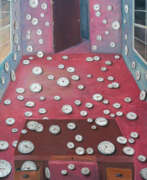

Derek Paul Boyle is a contemporary American visual artist whose work often deals with the anthropomorphism of everyday objects and absurdist interventions.
Boyle received his BFA from Emerson College in Boston and his MFA in Digital and Media Studies from Rhode Island School of Design.
Boyle has exhibited his work nationally and internationally, including exhibitions at the Museum of Modern Art in Cleveland, the Museum of Fine Arts in Boston and the Saatchi Gallery in London. His work is included in the collections of the Whitney Museum of American Art, the Museum of Fine Arts Boston, the Cleveland Museum of Art and others.
In addition to his studio practice, Boyle also teaches art and works as a visiting artist at various institutions, including the Rhode Island School of Design, the School of Visual Arts and the University of Michigan.
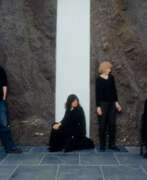

Mark Boyle is a Scottish media artist from the British underground.
Since 1985 he and his wife Joan Hills and their children Sebastian and Georgia formed a collaborative art group called The Boyle Family. The Boyle family experimented with different techniques and styles. This included performances and events, films and projections, sound recordings, photography, electronic micro-photography, drawing, assemblage, painting, sculpture and installation.
However, their most famous long-term project remains Journey to the Earth's Surface, which they began in 1964 and which is a continuum of strange and interesting works. These paintings-very precise drawn casts, something in between painting and sculpture-are careful recreations of randomly selected sections of the earth's surface using resin and fiberglass, as well as real materials collected from the site under investigation.
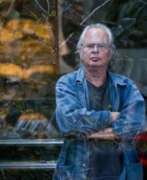

Miguel Rio Branco, full name Miguel da Silva Paranhos do Rio Branco, is a Brazilian photographer, artist, director and creator of multimedia installations.
His father was a diplomat and as a child Miguel lived in Spain, Portugal, Switzerland and the USA, now living and working in Rio de Janeiro, Brazil. After earning a degree in photography from the New York Institute of Photography, Miguel first worked as a cameraman and then worked with the Magnum agency. Miguel is known for exploring and crossing two different art forms: painting and photography. He has also shot 14 short films and eight long films, he is recognized in the world as one of the best color photojournalists.
Miguel Rio Branco's photographs are part of the collections of the Museum of Modern Art and the Metropolitan Museum of Art in New York.


Nick Brandt is a British photographer. He is known for his black and white photographs of wildlife and landscapes in Africa.
Brandt began his career in photography working as a music video director in the 1990s before transitioning to fine art photography. His work often depicts the animals of Africa in a powerful and emotive way, highlighting the beauty and fragility of these creatures and their natural habitats.
Brandt's photographs have been widely exhibited and are included in the collections of many major museums, including the National Portrait Gallery in London, the Museum of Fine Arts in Houston, and the Smithsonian National Museum of African Art in Washington, D.C. He has also published several books of his photography, including "On This Earth," "A Shadow Falls," and "Across The Ravaged Land."
In addition to his photography, Brandt is also the founder of the Big Life Foundation, a non-profit organization dedicated to the conservation of wildlife and ecosystems in East Africa. He has received numerous awards and honors for his photography and conservation work, including the prestigious Wildlife Photographer of the Year award.
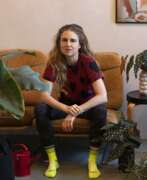

Kerstin Brätsch is a German contemporary visual artist who often creates large-scale, highly abstract works that combine multiple media. She studied at the University of Art in Berlin and Columbia University in New York and received a Master of Fine Arts degree in 2007. She currently lives and works in New York.
Brecht creates large works that she exhibits in a particular manner. This is as far as possible from the standard form of exhibiting artwork. She hangs her works on magnets, inserts them in double glass frames and rests them against the wall, leaving them on the floor. Using this peculiar method of presentation, she combines a bit of performance art into her visual works.
In 2014, Bratsch was awarded the August Macke Prize. In 2017, Bratsch was awarded the second Edvard Munch Art Prize, which is a cash prize and a solo exhibition at the Munch Museum in 2019.
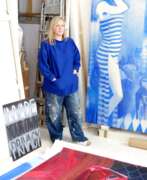

Lisa Brice is a South African painter and visual artist from Cape Town. She lives in London and cites some of her influences as her experiences growing up in South Africa during a time of political upheaval, and from time spent living and working in Trinidad.
Her work is held in collections around the world, including the Smithsonian National Museum of African Art, Johannesburg Art Gallery, The Whitworth, the High Commission of South Africa, London and the private collection of Sindika Dokolo.
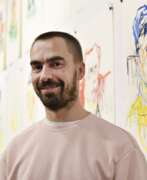

Guillaume Bruère is a French painter, drawer, sculptor and performer. He lives and works in Berlin.
Guillaume Bruère graduated from the Ecole des Beaux-Arts de Nantes (DNSEP) in 1999, then from the Ecole Européenne Supérieure de l'Image in Poitiers in 2003.
Fascinated by the major artists of art history (Holbein, Dürer, Rembrandt, Goya, Van Gogh, Giacometti, Picasso, Bacon), Guillaume Bruère has been working since 2009 in many museums and prestigious institutions (e.g. Kunsthaus Zürich, Musée Picasso Paris, Fondation Vincent Van Gogh Arles) to reinterpret their works, notably through drawing.
From his confrontation with the art of the past (Egyptian, Greek, Mexican, heraldic art, etc.), a singular, dense universe of extraordinary vitality emerges through the use of colour, the expressiveness of his gesture, the sureness of his line, and collage, which can be found in many of his drawings, but also in his painting, sculpture and performances.
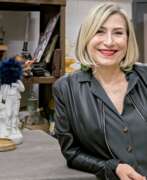

Carmen Calvo, full name Carmen Calvo Sáenz de Tejada, is a Spanish conceptual artist and sculptor.
Carmen Calvo is one of the most representative Spanish conceptual artists of our time. She studied at the School of Arts and Crafts and then at the School of Fine Arts of Valencia, worked in a ceramic factory and since then always incorporates fired clay in her plastic compositions. The artist also works in scenography using photography and other, very diverse formal, technical and thematic resources.
In 2013, Carmen Calvo was awarded the National Award for Plastic Arts by the Ministry of Education, Culture and Sport, and in 2014 she was appointed Academician of the Royal Academy of Fine Arts of San Carlos de Valencia.
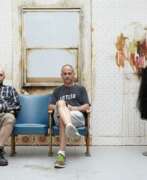

Jake Chapman, born Iakovos Chapman, is an English conceptual artist who works almost exclusively with his older brother Dinos Chapman. Together they are known as Jake & Dinos Chapman and became famous as members of the Young British Artists, brainchild of media mogul and collector Charles Saatchi. The brothers usually create works using plastic models or fibreglass mannequins, which often cause scandal.
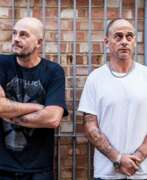

Dinos Chapman (born Konstantinos Chapman) is an English conceptual artist who almost always works with his younger brother Jake Chapman. Together they are known as Jake & Dinos Chapman and became famous as members of The Young British Artists, brainchild of media mogul and collector Charles Saatchi. The brothers usually create works using plastic models or fibreglass mannequins, which often cause scandal.
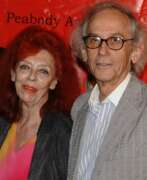

Christo & Jeanne-Claude are an art duo, the married couple Christo Vladimirov Javacheff (1935-2020) and Jeanne-Claude Denat de Guillebon (1935-2009), an iconic pair of innovative land-art artists. They are known for their large-scale installations: they are packing great historical landmarks, working with huge spaces and monumental natural objects. Their projects are distinguished by what they call "Americanism" in Europe - that is, something grandiose and large-scale. Christo and Jeanne-Claude's work is in many major public collections.
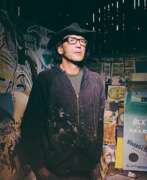

Andrzej Cisowski is a Polish multimedia artist and graphic artist.
Cisowski graduated from the Academy of Fine Arts in Warsaw and was initially associated with the Neue Wilde movement (Neo-Fauvism). Over time he developed his own individual style on the border of figurative painting and new expression. The artist also created paintings based on old photographs.
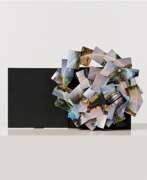

Peter Coffin is an American artist. He is known for his conceptual and interdisciplinary works that explore the relationship between humans and the natural world.
Coffin's work often incorporates a range of media, including sculpture, painting, photography, video, and performance. He frequently engages with scientific and philosophical concepts, such as the nature of perception and the relationship between humans and animals.
Coffin's work has been exhibited in major museums and galleries around the world, including the Hirshhorn Museum and Sculpture Garden in Washington, D.C., the Whitney Museum of American Art in New York, and the Centre Pompidou in Paris.
He has received numerous awards and grants for his work, including a Guggenheim Fellowship in 2013. Coffin's work is noted for its ability to bridge the gap between art and science, and to encourage viewers to think critically about their place in the world.
Peter Coffin lives and works in London.
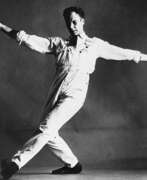

Mercier Philip "Merce" Cunningham was an American dancer and choreographer who was at the forefront of American modern dance for more than 50 years. He frequently collaborated with artists of other disciplines, including musicians, graphic artists and fashion designers. Works that he produced with these artists had a profound impact on avant-garde art beyond the world of dance. There have been numerous exhibitions dedicated to Cunningham's work. Also, his visual art is represented by Margarete Roeder Gallery.
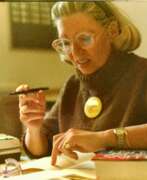

Betty Danon is a Turkish-born artist who has worked in Italy.
She created her works in a variety of techniques: painting and collage, graphics and performance, mail-art and sculpture, hundreds of works on paper and canvases. Betty Danon sought to convey the harmony of sound and sign with all the means available to her.
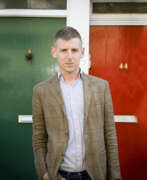

Matthew Darbyshire is a British artist. He is known for his multimedia works that explore contemporary consumer culture and the built environment.
Darbyshire often works in sculpture, installation, and photography, using materials such as concrete, metal, and plastic. His work often references the aesthetics of modernist architecture and design, and he frequently incorporates found objects and images from popular culture into his pieces.
In 2014 Darbyshire created the polystyrene sculpture Hercules, which is an imitation of the Farnese Hercules. The deliberate choice of a white material has been interpreted as a perpetuation of colourism in how we view and understand classical sculpture.
Darbyshire's work has been exhibited in major museums and galleries around the world, including the Tate Britain in London, the Museum of Modern Art in New York, and the Venice Biennale. In 2015, he was shortlisted for the Hepworth Prize for Sculpture.
His work is noted for its critical engagement with consumer culture and the built environment, as well as its use of humor and playfulness to explore complex social and cultural issues.
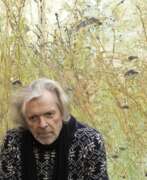

Jiří David is a contemporary Czech artist working in various techniques, including painting, sculpture, installation and photography. Co-founder of the art group Tvrdohlaví . His most famous media work is the neon heart over Prague Castle at the end of the last term of President Václav Havel.
Jiří David studied at the Prague Academy of Fine Arts. His work is characterised by a conceptual approach and a critical engagement with art history and social issues. He often creates large-scale installations that engage the viewer and explore the relationship between art and its audience.
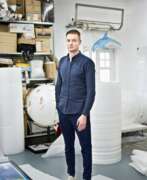

Simon Denny is a contemporary artist from New Zealand, born in 1982. He works with a variety of media including sculpture, installation, video, and printmaking. Denny's work often explores the intersection of technology, politics, and economics. He is particularly interested in how technological systems shape our lives and societies. In his art, he frequently uses images and objects related to the tech industry, such as circuit boards, computer servers, and software interfaces. One of Denny's most well-known works is "Secret Power," which was exhibited at the 2015 Venice Biennale. The installation focused on the activities of the Government Communications Security Bureau (GCSB), New Zealand's intelligence agency. It included a recreation of the agency's boardroom, as well as a series of prints and sculptures that explored the agency's role in global surveillance. Denny has exhibited his work internationally, including at the Museum of Modern Art (MoMA) in New York, the Serpentine Gallery in London, and the Biennale of Sydney. In 2019, he was awarded the prestigious Ars Viva Prize for Visual Arts.
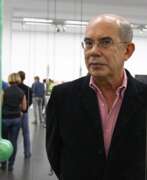

Antonio Manuel Lima Dias was a Brazilian artist and graphic designer. He was a prominent figure in concrete art. He studied at the National School of Fine Arts of Rio de Janeiro.
Antonio Lima Dias has undertaken study trips around the world since 1965, travelling to Paris, Milan, Berlin, New York and Nepal. Diaz's artistic style was characterised by a bold and confrontational approach. He used a combination of figurative and abstract elements, bright colours, strong lines and dynamic compositions.
In 1992 he became a professor at the Sommerakademie für bildende Kunst in Salzburg, Austria, and the following year at the State Academy of Fine Arts in Karlsruhe, Germany.One of his characteristics is his use of handmade paper, combining texture and colour in his work. One of his main characteristics is his use of handmade paper, combining texture and colour in his works.
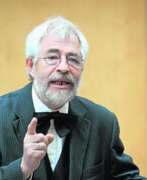

Manfred Dinnes is a German painter, sculptor, writer and art gallery director. He was also cultural editor of Europeonline magazine.
Manfred Dinnes travelled around the world to study other cultures in his youth. In 1973-74 he trained as a church painter-restorer. At the same time he was introduced to the craft of glass painting and glass blowing. Graduated from the Academy of Fine Arts in Nuremberg in 1979, where he studied freehand painting with Gerhard Wendland, Ludwig Scharl and Franz Wintzinger.
Since founding Visual-Art Concepts in 2007, Dinnes has created large sculptures from 7 to 8 metres in height.
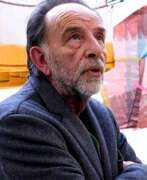

Noel Dolla is a French installation artist.
Dolla was the youngest and most important member of the Supports/Surfaces group that emerged in France in the late 1960s. From 1969 until today he has been working with landscapes under the title "Reconstructing Space".
Noel Dolla works in many techniques and with a variety of materials, from fabrics, including kitchen towels and pillowcases, and fishing tackle, to craters on the beach and wax figures.
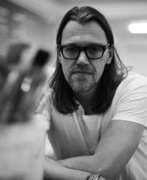

Jörg Döring is a German mixed media artist, one of Germany's leading neo-pop artists. Using screen printing, silkscreening, photo collage, acrylic, spray paint and oil on canvas, Döring depicts various comic, cartoon characters and pop icons. The source materials for his work are photographs, books, old magazines, drafts, print samples, packaging, sketches and more, from which he creates large-scale and multimedia works.
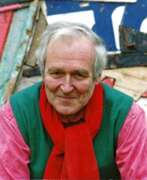

Bertrand Dorny is a French abstractionist artist, painter, printmaker and graphic designer.
Originally a painter, Dorny became interested in various techniques, particularly printmaking, in which he achieved great success and recognition. He created more than 650 engravings.
Dorny enjoyed working with wood and paper, from which he created intricate collages, reliefs, and assembled large wooden panels. He also worked in the field of book collage.
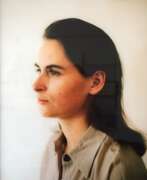

Jeanne Dunning is an American photographer whose work is centered around corporeality and human physicality in abstract forms. Dunning earned her Bachelor of Arts from Oberlin College and her Masters of Fine Arts from The School of the Art Institute of Chicago. From there, she opened her first exhibit at the Feature Gallery in Chicago in 1987. In the early 1990s, Dunning created a series of photographs for an exhibit titled "Directions" which was meant to blur the lines of fact and fiction.The exhibit was displayed at the Hirshhorn Museum in Washington. Dunning's work is included in the permanent collections of the Art Institute of Chicago, the Whitney Museum of American Art, the Museum of Contemporary Art, Chicago, the Museum of Contemporary Photography and the Museum of Modern Art, New York.
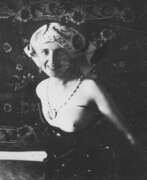

Sofya Isaakovna Dymshits-Tolstaya (Russian: Со́фья Исааковна Ды́мшиц-Толста́я) was a Russian avant-garde artist and graphic designer, whose life and work were intertwined with the tumultuous events of early 20th-century Russia. Born in St. Petersburg, she studied under Sergei Egornov, at Elizaveta Zvantseva's School of Drawing and Painting, and later in Paris under Jacques-Émile Blanche and Charles Guérin. Dymshits-Tolstaya contributed to exhibitions from 1912, marking her entry into the vibrant art scene of the time.
Dymshits-Tolstaya's work spans a range of subjects and styles, including propaganda posters and a series of portraits of women, which reflected the changing roles and perceptions of women in Soviet society. Her pieces like "Agitator Worker" (1931) and "Evdokia Fedotova, Chairwoman of the Second Congress of Collective Farm Shock Workers" (1935-1938) showcase her commitment to depicting the new Soviet woman, combining elements of realism with a keen sensitivity to the social dynamics of her era.
Throughout her career, Dymshits-Tolstaya was closely associated with key figures in Russian art and literature, including her marriage to Alexei Tolstoy and her involvement with Vladimir Tatlin, which positioned her at the heart of the avant-garde movement. Despite the personal and political challenges she faced, including the loss of her husband Herman Pesatti to the Gulag, Dymshits-Tolstaya's legacy as a pioneering artist remains significant. Her works are celebrated for their historical value and artistic merit, reflecting the complexities and contradictions of Soviet Russia.
For art collectors and enthusiasts, Dymshits-Tolstaya's work offers a unique window into the avant-garde movement and the socio-political landscape of early 20th-century Russia. Her contributions to art and her remarkable life story continue to inspire and captivate audiences around the world. To stay updated on new sales and auction events featuring Sofya Isaakovna Dymshits-Tolstaya's works, sign up for updates and explore the rich heritage of this exceptional artist.
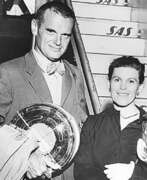

Charles Eames and Ray Eames were an American couple of industrial designers who made significant historical contributions to the development of modern architecture and furniture through the work of the Eames Office.
Charles and Ray Eames also worked in industrial and graphic design, fine art and film. Charles was the public face of Eames Office, but Ray and Charles worked together as creative partners and engaged a diverse creative staff. Some of their best known designs include the Eames Lounge Chair and the Eames Dining Chair.
The Charles and Rae Eames design firm has existed for over four decades.
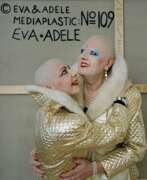

Eva & Adele are an artistic couple who claim to have "landed their time machines" in Berlin after the Wall fell in 1989, claiming to be "hermaphrodite twins from the future". Both refuse to tell their real name or age. They are famous mainly for sharing an invented gender, which is neither male nor female.
They are also known for their performance art, they have been represented by an art gallery since 1997, as they make paintings, video art, photography and costume design. They also have their own perfume line and a watch with Swatch.
They have been recognized as the world's longest running performance art duo and are often photographed as fashion icons at art events, like Art Basel Miami Beach and the Venice Biennale.
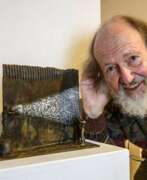

Michel Favre is a Swiss painter and sculptor living and working in Martigny.
Michel trained as a marble sculptor from a young age: learning to work with materials, honing his craft and technical skills, and practicing restoration. In 1972 he opened his atelier in Martigny and until 1980 he created almost exclusively stone sculptures, but since the 1990s he has incorporated bronze, glass and other materials into his work. Since 1996 he has also created video installations, combining plastic arts, film, photography and new media. Michel Favre travels extensively and is passionate about archaeology.
The main motif of the sculptor's works is the fragile human being in a looming world of machines and technology. In his three-dimensional images, people are most often tiny and ant-like, trying to change something in the huge world around them.
Michel Favre has been a member of VISARTE (Society of Swiss Artists, Sculptors, Architects) since 1983 and has been active in numerous exhibitions around the world.
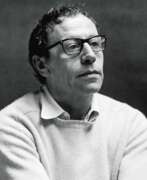

Robert Filliou is a French postmodern artist and poet, author, director and producer of videos and sculptures, working in the genres of happening and performance art. Filloux was a member of the Fluxus movement and the creator of the concept of the Museum in a Hat.
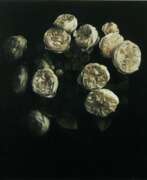

Norbert Fleischmann is an Austrian artist whose passion for painting can be called encyclopedic, because it encompasses a variety of styles and genres, motifs, painting styles and media influences, even forms of presentation and representation.
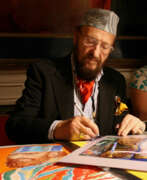

Ernst Fuchs was an Austrian painter, draftsman, printmaker, sculptor, architect, stage designer, composer, poet, and one of the founders of the Vienna School of Fantastic Realism. In 1972, he acquired the derelict Otto Wagner Villa in Hütteldorf, which he restored and transformed. The villa was inaugurated as the Ernst Fuchs Museum in 1988.
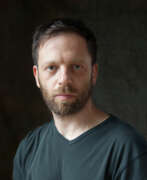

Ori Gersht is an Israeli photographer and video artist. He is known for his use of photography and video to explore themes of memory, history, and conflict.
Gersht's work often involves the use of slow-motion and high-speed video, which allows him to capture the ephemeral and fleeting moments that are often overlooked in daily life. He also uses a range of photographic techniques, including still life and landscape photography, to create images that are both beautiful and haunting.
Some of Gersht's most famous series include "Time After Time," which captures the moment of a bursting flower, and "Liquidation," which explores the destruction of historical objects. He has also created video installations that examine the history and memory of the Holocaust.
Gersht's work has been exhibited in major museums and galleries around the world, and he has received numerous awards and honors for his contributions to the field of photography and video art. He continues to produce new work and is widely regarded as one of the most important contemporary artists working today.
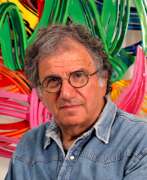

David (Dudu) Gerstein is an Israeli painter, sculptor, draftsman and printmaker.
Gerstein received a broad education: he studied at the Bezalel Academy, then at the École des Beaux-Arts in Paris, in New York he continued his studies at the Art Students League, and in 1974 he received a diploma from St. Martin's School of Art in London. He works freely in all media: printmaking, painting, sculpture, drawing, murals and monumental creations.
In the 1970's Gerstein began experimenting with three-dimensional works, leaving cut-out fragments hanging in space. After many innovations, David began creating wall sculptures made with laser cutting and automotive paint. He created his own kind of pop art and gained an international reputation for his signature style with colorful images of numerous cyclists, butterflies, dancers, runners and more. With the advent of computers, he was able to convert his drawings into perfectly formatted patterns that can be faithfully reproduced in a metalworking shop.
And Gerstein's recognizable monumental sculptures can be seen in cities around the world. His street sculpture Momentum is Singapore's tallest public sculpture.
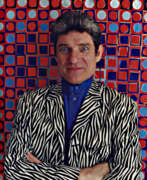

Horst Gläsker is a German universal artist.
Gläsker studied first as a designer, then at the Düsseldorf Academy with Gerhard Richter and K. Götz. Glesker has played a decisive role in shaping the art world of Germany and especially Düsseldorf since the 1980s. His work is a symbiosis of music, dance, theater, drawing, painting, sculpture, installation and architecture. This artist blurs the boundaries of art and works across media and disciplines.
Gläsker combines his installations with architecture, for example, like his works in public spaces in Frankfurt, Oberhausen and Erfurt. In another direction of his work, the artist combines various paintings with photography and creates photographic paintings. In this process he also collaborates with renowned photographers.
Horst Gläsker has worked as a professor at the Kunstakademie Münster, the Braunschweig University of the Arts and the Kassel Art College. Since 2006 Glesker lives in Düsseldorf and is a member of the Association of German Artists.
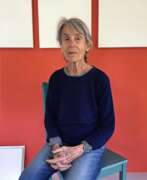

Marcia Jean Hafif was an American artist known for her contributions to the Minimalist and Conceptual art movements. She began her artistic career in the 1950s, exploring various mediums and styles before finding her distinctive voice.
Hafif's work often focused on the exploration of color, light, and the essence of materials. She was particularly interested in the interplay between perception, process, and the physicality of paint. In the 1970s, Hafif embarked on her groundbreaking series titled "The Inventory," where she meticulously painted a series of monochromatic works, each dedicated to exploring a specific color. These paintings emphasized the qualities and variations of a single hue, challenging traditional notions of representation and expanding the possibilities of color as a subject matter.
Later in her career, Hafif extended her exploration of color to include a broader range of media, such as photography, film, sound, text, installation, and printmaking. She continued to push boundaries and experiment with different materials and processes, always striving to deepen her understanding of color's impact on perception and experience.
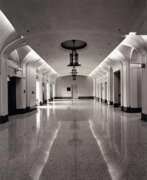

Doug Hall is an American photographer and media artist, who has received national and international recognition for his work in a range of practices including performance, installation, video, and large scale digital photography. He was a member of T. R. Uthco Collective (1970–1978). From 1981 to 2008, he was a member of faculty in the New Genres Department at the San Francisco Art Institute (SFAI). After retiring from the SFAI, he joined the Graduate Fine Arts faculty at the California College of the Arts (CCA) from 2008 to 2015.
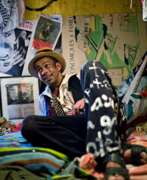

David Hardy, working under the name Le Suisse Marocain (Swiss Moroccan), is an artist and gallerist who considers himself cosmopolitan.
Born in Germany, David studied at the State Academy of Fine Arts in Karlsruhe, lives mainly in Paris, but also in Sicily, Madagascar or Japan. In 1996, in the center of Paris, he set up a studio in what eventually became one of the most famous Parisian art centers called the artists' house "59Rivoli". This is where David Hardy lives and exhibits regularly. This huge studio is a hybrid of living and exhibition space and at the same time the artists' collection, the Igor Balut Museum.
David Hardy, through his work, embodies the idea of the artist as a cosmopolitan. Through sketches, copies and collages he makes the world his own. He paints everything around him, even the suitcases in which his work arrives and his clothes. Each of his works of art has its own biography, each object has its own destiny. He calls himself Roi de Rien, "King of Nothing" - a humorous and radical artist-poet who creates for the sake of creating.
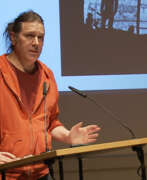

Axel Heil is a German artist and producer living in Karlsruhe and Basel.
He studied at the State Academy of Fine Arts in Karlsruhe, studied painting in Paris and The Hague, and art history and philosophy at the University of Heidelberg. Since 20021 he has been Professor of Experimental Processes of Translation and Writing at the Karlsruhe State Academy of Fine Arts.
Axel Heil is the founder of Liquid Editions, a platform for a wide variety of projects and research. Since 2008 he has been the editor of the series "The Future of the Past", monographs on artists of the 1960s.
The artist works in mixed media. He uses a variety of media: objects, installations, combined paintings, video and photographic works, which are equally combined in his works.
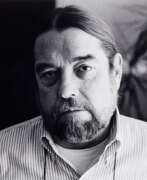

Robert Heinecken was an American artist and educator. He is known for his pioneering work in the field of photography, particularly his use of found images and his experimentation with photographic processes.
Heinecken studied at the University of California, Los Angeles, and later became a professor of art at UCLA, where he taught for over 30 years. He exhibited his work extensively throughout his career, including at the Museum of Modern Art in New York, the Whitney Museum of American Art, and the San Francisco Museum of Modern Art.
Heinecken's work often involved appropriating images from mass media sources, such as magazines and television, and recontextualizing them in his art. He was also known for his "paraphotography," a term he coined to describe his use of photographic materials and techniques to create works that were not necessarily photographs in the traditional sense. For example, he would use photographic paper to create abstract, three-dimensional sculptures, or he would manipulate images with chemicals to create surreal, dreamlike compositions.
Heinecken's work has been praised for its critical engagement with the role of photography in contemporary culture, as well as its wit, playfulness, and subversive edge. He was a major influence on the development of conceptual art and postmodernism in the United States, and his legacy continues to be felt in contemporary art today.
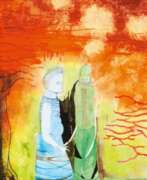

Lothar Hempel is a German media artist living and working in Berlin.
Lothar studied at the Academy of Fine Arts Düsseldorf and works in a wide range of media, combining the abstract and figurative in dramatic stage sets. Drawing from a variety of styles - Dadaism, Constructivism, the Bauhaus school - Hempel creates works in the fields of sculpture, drawing and painting, video, performance and installation. He utilizes visual metaphors, including images or found objects.
Lothar Hempel has been exhibiting regularly since 1991.
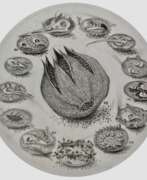

Hipkiss is the pseudonym of Alpha and Christopher Mason, both artists born in 1964 in Britain.
The artists began working together in the UK, then moved to France, where they continue to live and work. They are known for detailed, detailed figurative drawings created in a mixed media technique that combines pencil, silver ink and metallic foil. The artists draw large-scale urban landscapes, landscapes, strange insects, plants and birds, depicting images of a utopian future where nature has conquered the industrial environment.
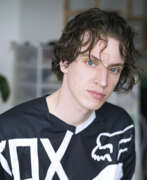

Yngve Holen is a contemporary German artist.
In his work, Holen often explores the relationship between technology, consumer culture and the human body. He often uses industrial materials and objects in his sculptures and installations, and his work often has a minimalist and futuristic aesthetic.
Yngve Holen's work expresses a sensitivity to the ever-growing identification of man and machine, the body and consumer culture, where objects define us as much as we define them. His work reflects on how these boundaries are shifting and expanding, manipulated and stretched, both in the technological and social sphere, where they collide with new ontologies. Objects of consumption are carefully and clinically dissected; car headlights take on anthropomorphic qualities; computer tomograph components become futuristic portals to a new reality.
Holen has exhibited his work widely in Europe and North America, including exhibitions at the Venice Biennale, the Stedelijk Museum in Amsterdam and the Museum of Modern Art in Chicago. He is also the recipient of numerous awards and grants. He currently lives and works in Berlin.
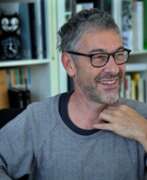

Pierre Huyghe is a French artist born on September 11, 1962, in Paris, France. He is known for his interdisciplinary works that combine various media such as film, sculpture, performance, and installation. Huyghe's works often explore complex ideas around time, memory, perception, and human consciousness.
Huyghe studied at the École nationale supérieure des Arts Décoratifs in Paris before beginning his career as an artist in the late 1980s. Since then, he has exhibited his works in numerous solo and group shows around the world, including at major institutions such as the Guggenheim Museum in New York, the Tate Modern in London, and the Centre Pompidou in Paris.
Some of Huyghe's most notable works include "The Host and the Cloud," a multimedia installation that took place over a period of three years at the Marian Goodman Gallery in New York, and "Untilled," a sculpture of a reclining figure with a living beehive for a head, which was displayed at the Documenta 13 exhibition in Kassel, Germany. In 2017, Huyghe was awarded the Nasher Prize for Sculpture, which recognized his contributions to the field of contemporary art.
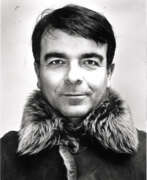

Fabrice Hybert, also known by the pseudonym Fabrice Hyber, is a French plastic artist. At 56, he was elected to the Academy of Fine Arts on April 25, 2018. Attached to nature, economics, commerce and science, he has created systems around artistic production with companies, scientists and laboratories around the world. Renowned artist, he works in many diverse ways - accumulating, proliferating, hybridizating - sliding between painting, sculpture, installation and video.
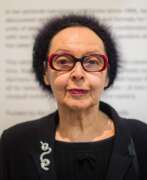

Dorothy Iannone is an American artist who lived and worked in Germany for a long time. Most of Iannone's paintings, texts and films are about erotic love. Freedom, free love, uninhibited sexuality are the central theme of the artist's images.
Yannone's depictions of the human body are largely based on Greek and Oriental motifs, Japanese prints, and the fine art of Tibetan and Indian religions.
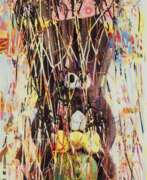

Parker Ito is an American contemporary artist. He was raised in Long Beach, California and currently works in Los Angeles. Ito's art practice encompasses a wide range of media, including painting, sculpture, video, performance, and installation.
Ito is known for his exploration of the intersection of technology and contemporary art. He often incorporates digital elements into his work, such as using UV printing on canvas, digital painting, and 3D printing. Ito's work also frequently deals with issues of identity, representation, and the commodification of art.
Ito has exhibited his work in numerous solo and group exhibitions in galleries and museums around the world.
